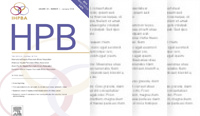International Hepato-Pancreato-Biliary Association
HPB Blog: June 2016

HPB Blog June
Many IHPBA members will be fired up with research questions and ideas after the recent inspirational IHPBA 2016 Congress in Sao Paolo. The quality and diversity of presentations was excellent and the editorial team at HPB look forward to receiving your manuscripts for consideration of publication.
The June edition of HPB has articles which pick up on some of the themes discussed in Brazil. Villani and colleagues ask “what is the learning curve for laparoscopic liver resection?” in their article. The manuscript highlights the fact that laparoscopic liver resection is not a single procedure and with experience come more challenging cases and so the complication rate typically falls with experience and then increases with complexity.
On the theme of laparoscopic surgery, minimally invasive liver resection(MILR) is not something which is immediately associated with children. Veenstra and Kofforn, from Oakland, California provide evidence that MILR is safe and effective and can be successful in the majority of cases even when a high proportion of children were undergoing hemihepatectomy and some were as young as 9 months of age.
Chapelle and colleagues from Antwerp, Belgium present apaper combining mebrofenin technetium scintigraphy with MRI volumetric analysis to try to predict post hepatectomy liver failure (PHLF) in patients undergoing liver resection. Their study shows that predicting the future liver remnant estimated function based on mebrofenin scanning was the best correlate with developing post hepatectomy liver failure and superior in predictive ability than than 40% FLR volume. This study is useful as it puts a number on liver function. It will be interesting to see how this research theme develops and if this correlates with PHLF in patients with background liver disease eg cirrhosis.
Li et al from Shanghai performed a nonrandomized trial of patients with HCC who had main portal vein invasion. Patients were treated either with preoperative radiotherapy targeted on the tumour thrombus followed by surgery or surgery alone. They found significantly improved survival rates and reduced recurrence in patients who received radiotherapy.
Lim and colleagues from Creteil, Paris looked at the incidence and consequence of acute kidney injury in patients undergoing resection of hepatocellular carcinoma. The rate of AKI was related to severity of liver disease, age, extent of surgery and long duration of surgery and was associated with worse short term outcomes although it had no impact on long term survival. The latter is perhaps surprising given that almost half of patients never recovered their original kidney function.
To finish up on the liver theme, my own colleagues and I present a systematic review of systemic adjuvant, neoadjuvant and perioperative chemotherapy for resectable colorectal cancer. This study highlights the lack of really good quality evidence in this field but confirms that there is significant benefit from combining using Folfox treatment with surgery versus surgery alone.
Moving to the pancreas, Baldwin and colleagues from Buffalo NY have provided evidence that patients undergoing pancreatic cancer with just 1-2 lymph nodes involved have similar outcomes compared with those with no lymph node involvement. A greater lymph node burden was associated with worse prognosis as might be expected. They call for stratification of patients dependent on the extent of lymph node involvement.
Finally The French Surgical Association present a collaborative study looking at the outcomes of children with congenital biliary cysts (choledochal cysts). This is a rare condition however the authors managed to assimilate over 300 cases and compared presentations and outcomes between adults and children. Children had lower rates of cancer, less major surgery, less morbidity and a more benign indolent clinical course. The Todani type 4a cysts (diffuse intra and extrahepatic) were however a clinically worse and more symptomatic cyst type in children.
Stephen J Wigmore
Click here for the June of Contents
Stephen J Wigmore
Corporate Partners
If you are interested in becoming a Corporate Partner of the IHBPA please contact industry@ihpba.org
Find out more


